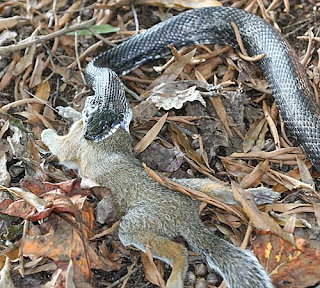Description: Adult rat snakes are typically 3-5 ft (91-152 cm), but large
individuals may be more than 6 ft (183 cm) long. The appearance of rat snakes
varies greatly throughout the geographic range. Black rat snakes are more
northern in distribution and are characteristically black on top with a faint
hint of white between some of the scales. Yellow rat snakes are greenish,
yellow, or orange with four dark stripes running the length of the body. Gray
rat snakes are dark to light gray with darker gray or brown blotches. The
juveniles of all subspecies resemble the gray rat. The belly is whitish in
color near the head and becomes checkered or mottled toward the tail. The body
cross section is loaf-shaped and not round. Rat snakes have weakly keeled
scales and the anal plate is divided.
 |
| Yellow rat snake |
 Habits: Adult rat snakes primarily eat mice, rats, squirrels, and
birds, as well as bird eggs. They are a common predator on wood duck eggs.
Juveniles eat small frogs, lizards, and small rodents. Rat snakes are
constrictors, and adept climbers that can scale brick walls as well as tree
trunks. When frightened they often assume a “kinked” posture and remain
motionless. They will vibrate the tail and expel malodorous musk.
Habits: Adult rat snakes primarily eat mice, rats, squirrels, and
birds, as well as bird eggs. They are a common predator on wood duck eggs.
Juveniles eat small frogs, lizards, and small rodents. Rat snakes are
constrictors, and adept climbers that can scale brick walls as well as tree
trunks. When frightened they often assume a “kinked” posture and remain
motionless. They will vibrate the tail and expel malodorous musk.
No comments:
Post a Comment